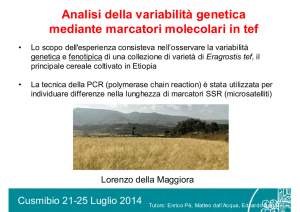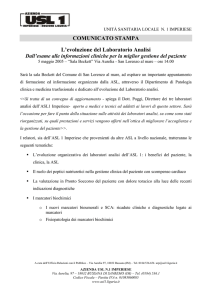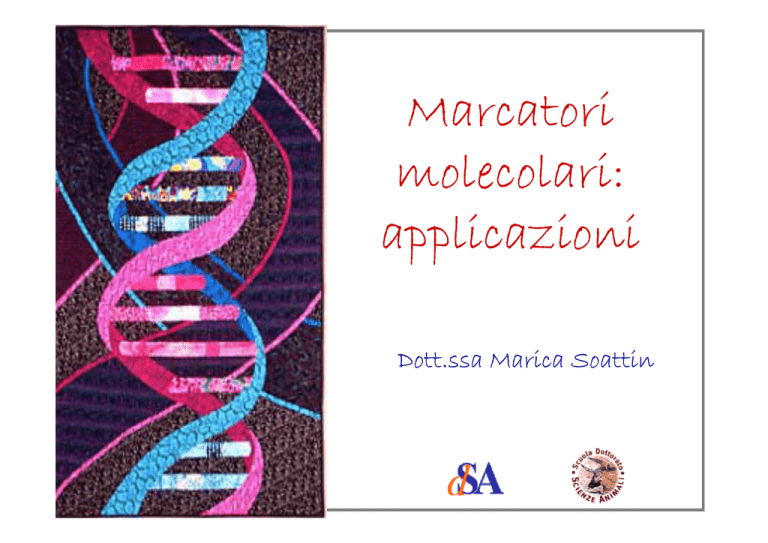
Marcatori
molecolari:
applicazioni
Dott.ssa Marica Soattin
Marcatori Molecolari
Strumenti affidabili ed efficaci per la l’analisi della struttura dei
genomi e del polimorfismo genico negli animali
Struttura genetica delle popolazioni e
flusso genico tra le popolazioni
Mappaggio di QTL e geni da
impiegare nella MAS
Multi-locus: AFLP (M-AFLP and S-SAP)
Single-locus: SSR and SNP
Studio struttura genetica delle popolazioni
I dati raccolti con i marcatori molecolari impiegati su una determinata
popolazione possono essere utilizzati per analizzare la struttura
genetica degli individui costituenti la popolazione
Indici di:
Diversità
genetica
Similarità
genetica
Calcolo
frequenze
alleliche
Fingerprints
Struttura popolazioni naturali
Le popolazioni naturali possono essere considerate come un insieme di
sottopopolazioni distribuite in una determinata area geografica e tra
loro parzialmente isolate dal punto di vista riproduttivo
risultato
Aumento dell’inbreeding con conseguente aumento
dell’omozigosi
misura
L’effetto sulla struttura genetica delle popolazioni può essere misurato
in termini di diminuzione delle frequenze degli eterozigoti
Calcolo frequenze alleliche
9 Marcatori co-dominanti
D=f a a
1 1
R=f a a
2 2
H=f a a
1 2
Conteggio diretto degli alleli
pa =(D+½H)
1
qa =1–p a =(R+½H)
1
2
9 Marcatori dominanti
pa =1–√(1-f b)
Assumere che la pop è in HW eq
1
f b =f a1a1+f a1a0
(1-f b)=f a0a0
pa =1–√(1-f b)
0
Le freq alleliche così ottenute possono essere usate per calcolare…..
Barcaccia & Falcinelli 2007 Volume III
Statistiche di diversità genetica: coefficiente di eterozigosità
Coefficienti di diversità genetica
HS
HS
HI
FST
HI
FIS
FIT
HT
HI
Eterozigosità media degli
individui nelle sottopop.
HS=1–Σpi2
Eterozigosità attesa nella
sottopolazione
HT=1–Σp–i2
Eterozigosità attesa nella pop
complessiva
Genetic distance (Nei,1978)
GDij=
–ln Σpipj
√Σpi2Σpj2
Barcaccia & Falcinelli 2007 Volume III
Statistiche di diversità genetica: coefficiente di inbreeding
Statistiche di Wright (1965)
–
HS–HI
FIS=
–
HS
Inbreeding degli individui rispetto alla sottopopolazione
HT–HI
FIT=
HT
Inbreeding degli individui rispetto alla popolazione totale
HT–HS
FST=
HT
Riduzione di eterozigosi di una sottopolazione rispetto
alla pop tot (Indice di fissazione per marcatori
dominanti)
–
Statistics of Nei (1973)
FST> = 0
(Differentiation degrees)
–
DST= HT–HS
DST
GST=
HT
Indice di fissazione per marcatori co-dominanti
Barcaccia & Falcinelli 2007 Volume III
Similarità e dissimilarità genetica
Tiene conto dell’insieme di marcatori raccolti nel campione che vengono
utilizzati per costruire matrici di similarità genetica calcolando i coeff.
relativi in tutte le combinazioni a coppia tra tutti gli animali
GSij=1
i
j
+
–
+
a
b
–
c
d
a
(a+b+c)
2a
GSij=
(2a+b+c)
2a
GSij=
(a+b)+(a+c)
a+d
GSij=
(a+d)+(b+c)
GSij=
GDij= 1–SGij
GSij=0,5
GSij=0
Jaccard (1908)
Dice (1945)
Nei and Li (1978)
Rohlf (1993)
Barcaccia & Falcinelli 2007 Volume III
Analisi di raggruppamento
Le matrici dei coefficienti di similarità e diversità genetica, calcolate a
partire dai polimorfismi molecolari,
possono essere impiegate per
costruire dendrogrammi e definire centroidi allo scopo di mettere in
evidenza le relazioni genetiche tra individui di pop naturali o sperimentali
appartenenti alla stessa specie
A1
A15
A19
A6
A4
A21
A22
A18
A7
A25
A28
A30
5
22
36
P9
B4
B18
B8
B12
B7
B5
B19
B14
B16
B6
B26
P7
B28
BR2
P1
P25
P6
P11
P20
15
27
P15
P18
P17
P33
2
3
17
43
18
39
13
P26
C4
C11
C29
C8
C14
C9
C26
C13
C15
C24
C21
C18
D9
D15
D5
D20
D4
D10
D17
D29
D7
D30
D27
D28
BR1
BR3
BR4
BR5
BR22
BR23
BR6
BR11
BR13
BR26
BR12
BR11
0.40
0.50
0.60
0.70
Similarità genetica di Dice
0.80
0.90
1.00
Dendrogramma
ottenuto attraverso
il metodo UPGMA
Applicazioni dei marcatori molecolari
Marker-assisted selection (MAS)
La selezione degli individui viene fatta sulla base della
presenza di un marcatore strettamente associato al gene o
QTL che controlla il carattere oggetto di selezione
La selezione genetica avviene ad uno stadio più precoce rendendo
così la procedura di valutazione molto più rapida con riduzione di
tempi e costi (performance test)
Esempio di applicazione dei marcatori molecolari
FB4
E4
Marcatore I-SSR331150 co-segregante con il colore del fiore
F1
QTL (Quantitative Trait Loci)
Uno dei loci o dei segmenti cromosomici dove risiedono i geni che
controllano l’espressione di un determinato carattere quantitativo
Un QTL può essere visto come un blocco cromosomico in grado
di controllare più caratteri quantitativi
La rilevazione dei QTL dipende dalla presenza di mappe
genetiche altamente sature e da osservazioni delle variazioni
fenotipiche per i caratteri agronomici di interesse
Costruite stimando le distanze reciproche di un numero molto
grande di marcatori stabilendo così la loro posizione reciproca
lungo il cromosoma (gruppo di associazione)
Per realizzare programmi di MAS è prima
necessario identificare marcatori molecolari o
geni associati a caratteri di interesse zootecnico
Mappaggio di caratteri mendeliani e QTLs
• Analisi di segregazione in popolazioni sperimentali
E’ possibile analizzare la co-segregazione
del carattere “mendelizzato” con il tratto
cromosomico identificato da un marcatore
molecolare
Barcaccia & Falcinelli 2007 Volume III
Mappaggio di caratteri mendeliani e QTLs
• Analisi del linkage disequilibrium in popolazioni naturali
La variabilità è dovuta al verificarsi di numerosi
eventi di scambio nelle regioni ad elevata
ricombinazione nei cromosomi
L’analisi degli eventi di ricombinazione è basata
sulla valutazione delle combinazioni degli alleli
di loci di uno o più cromosomi (aplotipi)
Barcaccia & Falcinelli 2007 Volume III
Applicazioni dei marcatori nel settore
zootecnico
•
Costruzione di mappe genetiche e fisiche
•
Mappaggio di geni utili
•
Mappaggio di QTL
•
Diagnosi di anomalie genetiche
•
Analisi di paternità
•
Stima della consanguineità e ausilio ai piani di
accoppiamento
•
Tracciabilità dei prodotti
•
Studi su filogenesi, variabilità genetica, struttura e
dinamica di specie e popolazioni
Chapter 2
Genomic DNA fingerprinting of chicken (Gallus gallus L.)
indigenous breeds with M-AFLP and S-SAP markers
designed on interspersed repeats
Chicken local breeds
Few highly specialized broilers have replaced local breeds
53 local breeds
61% are extinguished, 13% are threatened
6.7%
are preserved by specific conservation programs!
Local breeds conservation and valorization programs are essential
because:
Irreplaceable source of useful genes for rusticity,
adaptability and resistance to diseases
Increasing consumer interest due to social, historical
and economical reasons and to the perception that
autochthonous breeds are healthy and natural
Chicken genome organization
1200 Mbp
38 pairs of autosomes and 2 sex chr
5 macro-chromosomes
5 intermediate-chromosomes
28 micro-chromosomes
15% repetitive DNA fraction
Short tandem repeats
Long interspersed repeats
CR1 Chicken Repeat 1
Macro-chromosomes
Micro-chromosomes
Nanda et al. (2002)
Coullin et al. (2005)
Main objectives of the research
9Development
of an innovative molecular system of
population genomics for chicken DNA fingerprinting
based on the analysis of repetitive sequence families
(mini- and microsatellite)
9Cloning of breed-discriminant or breed-specific STS
molecular markers
Ermellinata
di Rovigo
Pépoi
2000 ind
Robusta
lionata
Robusta
maculata
Polverara Padovana
1500 ind
Methods: AFLP derived-markers
Genomic DNA fingerprints were generated in a sample representing the six
indigenous breeds and one broiler
S-SAP:
SAP Sequence-Specific Amplification Polymorphism (Minisatellite)
M-AFLP:
AFLP Microsatellite-Amplified Fragment Length Polymorphism
AFLP
Enzyme Eco-RI
Enzyme Taq-I
Adaptor-Eco
SSR- and CR1-anchored primers
Adaptor-Taq
Primer-Eco+NNN
Primer-Taq+NNN
S-SAP
Adaptor-Eco Minisatellite CR1
Primer-CR1
Adaptor-Taq
TG/CA repeat
M-AFLP
AGC/GCT repeat
SSR-specific primers
anchored at 3’ or 5’ end of
the repeat
Primer-Taq
S-SAP
M-AFLP
Adaptor-Eco
Microsatellite (AGC)n
Primer I-SSR
Adaptor-Taq
CR1-specific primers
designed on 3’ and 5’
regions of the element
Primer-Taq
CR1rev
CR1int
CR1for
M-AFLP and S-SAP fingerprints
AGC microsatellite
anchored
M-AFLP
Population genetics
study
CR1-internal
core
S-SAP
Selection and sequencing of polymorphic
breed-discriminant and breed-specific markers
Genetic relationships among local breeds and commercial
broiler based upon M-AFLP and S-SAP polymorphisms
M-AFLP
HT
HS
FST
M-AFLP
0.334 0.162 0.515
S-SAP
0.381 0.232 0.391
HT: Nei’s total genetic diversity
HS: Mean genetic diversity within single breeds
S-SAP
FST: fixation index
Mean Dice’s genetic similarity coefficients
within and between local breeds were 0.769
and 0.581, respectively
Chicken genome retrievals
Clone
Chr.
Accession
No.
Locus ID
Type
Gene product
#37
1
EF417921
NW 001471534 Intergenic
5’ Hypothetical protein – 3’ monoamine oxidase
B
#38
15
EF417922
NW 001471459
Genic
Hypothetical protein
#39
3
EF417923
NW 001471677
Genic
Acetyl-CoA Synthetase 2
#40
2
EF417924
NW 001471654 Intergenic 5’ Syntrophin beta 1 – 3’ Hyaluronan synthase 2
#42
3
EF417925
NW 001471671
#44
2
EF417926
NW 001471639 Intergenic
5’ hypothetical protein – 3’ Neuropilin- and
tolloid-like protein 1
#48
4
EF417927
NW 001471687
Genic
Fibroblast growth factor receptor-like 1
#50
1
EF417928
NW 001471525
Genic
Hypothetical protein
#51
26
EF417929
NW 001471609
Genic
Potassium voltage-gated channel, Shal-related
subfamily
#52
1
EF417930
NW 001471534
Genic
Interferon alpha/beta/omega receptor 1
#55
9
EF417931
NW 001471743 Intergenic
5’ Cek6 protein – 3’ Alpha-1,4-Nacetylglucosaminyltransferase
#56
17
EF417932
NW 001471503
Hypothetical protein
Genic
Genic
Sorting nexin 14
SCAR markers
Acrylamide blot
Breed-specific or -polymorphic
markers from M-AFLP or S-SAP
experiment
Isolation and purification of interesting fragments
Amplification and electrophoresis
Sequencing of amplified fragment and primer design
Specific-locus amplification and electrophoresis analysis of SCAR marker
SCAR molecular markers set up
The upper (333 bp) marker was
shared among the vast majority of
individuals over all local breeds.
#38
The lower (307 pb) marker
was detected only in the
Polverara individuals with a
relative frequency of 52%
#52
#55
No other discriminating SCAR
markers were detectable
Specific-clone sequencing and
SNP discover
Haplotypes definition
Breed
Clone # 38
Clone #39
Clone #50
67
251
189
191
C/T (A)
A
C
T
-
Padovana
C/T
A
C
T
Pepòi
C/T
A/C
T
Polverara
C/T
A/C
Rob. Lionata
C or C/T
Rob. Maculata
Ermellinata
Broiler
312
51
70
96
-
-
A
C
T
C
G
G
A
C
T
C
T
A
A
C
G
C
-
-
C
A
A
A
C
T
A
C
T
C
A
A
A
C
T
C or C/T
A
C
T
C
A
A
C
C
T
C/T (A)
A
C
T
C
G
A
C
C
T
Forward SNP site-specific
primer was designed with
its discriminant 3′-end in
the point mutation position
23 223
Clone #56
Conclusions
9S-SAP and M-AFLP marker systems were shown to
be suitable to produce informative fingerprints and
polymorphisms within/among local breeds and the broiler
9SCAR markers: not reliable for genetic
traceability because of SNPs undetectable by PCR
amplification (except for SCAR #38)
9SNP haplotypes: breed-specific and individual-
discriminant haplotypes were detected
9Breed-specific clones has shown homology with
genes implicated in metabolic processes
Chapter 4
Discovering of novel leptin gene-based SNPs and sequencetagged site genotyping of dairy sheep (Ovis aries L.)
populations
Australian Sheep
John and Elizabeth Macarthur are founders of the wool
industry in Australia
1797: dozen of Spanish merinos brought to Sydney from
South Africa
1807: beginning of trade for Australian wool industry
More than 80% of 100 millions of sheep is merino
Saxon merino
Spanish merino
Peppin merino
Awassi
South Aus Merino
(Goulburn)
Australian sheep
Wool
Meat
Milk
Many projects have been developing for mapping of QTL
associated with growth rate, body traits and milk composition
Australian Sheep Gene Mapping Web Site
http://rubens.its.unimelb.edu.au/~jillm/jill.htm
Sheep QTL database
Sheep comparative maps
Sheep and lactation
High pick milk:
animals are not able to consume adequate amounts of nutrients in the
first 3 weeks of lactation (NEGATIVE ENERGY BALANCE – NEB)
Flat lactation curve (=Persistent lactation)
- Animals less subjected to metabolic stress in early lactation
- More constant energy requirement throughout the lactation
More desirable
Sheep lactation curve features
Wood model (1967) is appropriate to explain the characteristics of the
sheep lactation curve (McGill, 2005)
Persistent lactation curve is
desirable because maintain a
positive EB and
consequently, a more
constant milk yield during
whole lactation
BCS, live-weight, NEFA, BHBA, leptin, protein, fat, lactose are used as
EB indicators.
Leptin physiology
- Small protein of 16 kDa
- Secreted by adipose tissue cells into the bloodstream
- Regulating food/feed intake and energy balance
- Regulating pituitary hormone secretion and hypothalamic- pituitary organ
interactions (adrenal, thyroid and gonads)
- Regulating body growth and development
- Involving reproductive function
- Function depending on OB-Receptor
Casanueva et al., 1999
Leptin gene
Structure characterized by Zhang et al., 1994.
It is located on HS-7, Bt-4, Oa-4
Gene structure is highly conserved across species
Mouse protein exhibits 83% homology with human leptin
Promoter
3 kb
Exon 1
Exon 2
Exon 3
33 bp
171 bp
360 bp
Intron 1
Intron 2
11 kb
1,7 kb
ATG
STOP
3’ UTR
Research goals
Leptin gene sequencing and SNP discovering using four
sires of the population Awassi x Merino (F1)
SNP-based genotyping exploiting both new and known
(Boucher et al., 2006) mutations on back-cross and double
back-cross ewe’s population
Evaluation of the correlation between genotypes/
haplotypes and some phenotypic traits
Experimental sheep population
SNP
detection
Genotyping
Heterologous primer design
3 kb
11 kb
33 bp
Promoter EX1
171 bp
1,7 kb
360 bp
EX2
In2
EX3
In1
Bos taurus
Homo sapiens
Sus scrofa
Sus scrofa
Ovis aries
Multi-alignment software: ClustalW and Workbench
Primer design software: Primer 3 and PerlPrimer
TOT ~ 9 kb
3’-UTR
Statistical analysis
Variance analysis to test if some correlations exist among identified
genotypes and different quantitative traits
Milking data
Lactation curve characteristics
Persistency (at 100, 80, 45 d)
Feed intake
Animal weight
Parity
Exp year (2005, 2006)
Leptin conc.
% Fat
% Protein
% Lactose
T max
Y max
Y tot
Optimization of PCR conditions
Promoter
EX1
In1
EX2
In2
EX33’UTR
Pr2
Pr3
Pr4
Pr5
Pr6
Pr/In1
In1/1
In1/2
In1/3
In1/4
Ex2
In 2b
In 2b
In 2c
Ex3
3’UTR
ID
1
2
3
4
5
6
7
8
9
10
11
12
13
14
15
16
Reliability
*
-
-
-
*
*
-
*
-
*
*
*
*
*
*
*
Size (bp)
600
703
659
400
539
631
590
621
570
609
15
1
16
1
5
2
12
3
4
8
530
5
15
6
7
9
11 primer combinations out of 16
generated good amplification products
for a total of 6.452 bp
SNP detection
The sequencing of sire 463 revealed two SNPs (both G/A) at positions
G170A G332A of EXON III
Missense mutations Arg>Gly
Both SNPs introduce site mutation for Msp-I and
HpyCH4V restriction enzymes
PCR-RFLP
markers
Single PCR product obtained by
Leptin-specific primers
amplification
Exo-SAP purification
Sequencing of purified fragment
SNP detection
Restriction
enzyme site
identification
Digestion of amplyfication products and
electrophoresis analysis of PCR-RFLP
markers
PCR-RFLP experiment
The entire experiment has been carried out on ewes belonging
to back-cross and double back-cross populations
192 females of 4 families were investigated
Family n. 1
Grand Dam
Grand Sire
Sire
*
GG
Family n. 2
Grand Dam
Grand Sire
Sire
*
AG
Only (*) family n. 2 has shown animals AG beside GG at
position 170 of EXON III
Genotypes frequencies
Family
size
Genotypes
Genotype Frequency
Allele Frequency
GG
AG
GG
AG
G
A
1
103
101
2
0.98
0.02
0.99
0.01
2a
35
17
18
0.49
0.51
0.74
0.26
2b
63
31
32
0.49
0.51
0.75
0.25
3
32
32
0
1
0
1.00
0
4
22
21
1
0.95
0.05
0.98
0.02
Overall
255
192
202
171
53
21
0.79
0.89
0.21
0.11
0.90
0.95
0.10
0.05
Genotype
F obs
F exp
AA
0
2.8
AG
53
47.5
GG
202
204.8
Ҳ2= 3.43 n.s
Statistical analysis results
In progress!!
Summarizing…
Leptin gene has been sequenced for ~ 5,000 bp
The sequencing allowed to discover two SNPs G/A at positions
170 and 332 of EXON III (missense mutation Arg>Gly)
The three SNPs reported by Boucher et al. (2006) have not been
detected in the ewe’s awassi and merino population
G170A and G332A mutation introduces respectively a variation on
Msp-I and HpyCH4V restriction enzyme site allowing the easy
recognition of these polymorphisms by PCR-RFLP
Summarizing…
Because of their contiguity, two SNPs might be in LD
The SNP G170A has been used for genotyping of 192 (255) ewes
for which phenotypic data were available
SNP genotyping revealed AG and GG genotypes with a frequency
of around 50% in the family number 2 and 10% (20%) in the entire
population
The population was found to be in HW equilibrium and the
absence of AA genotype is not significantly deviating

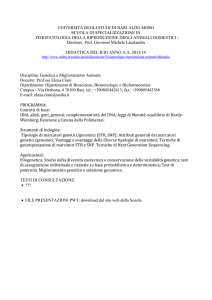
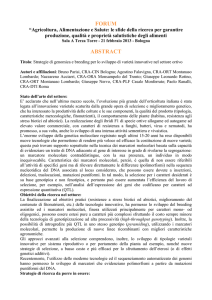
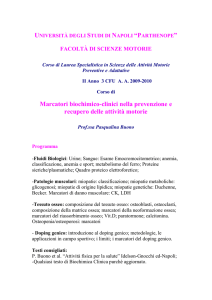

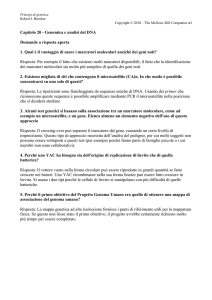
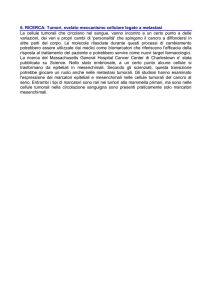

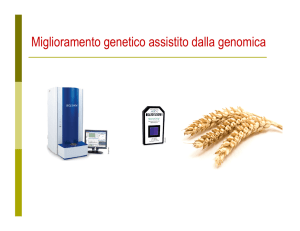
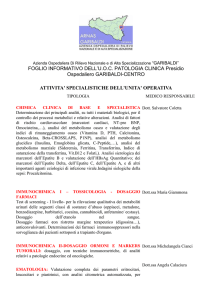
![modulo di consenso informato []](http://s1.studylibit.com/store/data/002425407_1-6cd2d73436cdc58f9ad99d2df8bf9f08-300x300.png)
